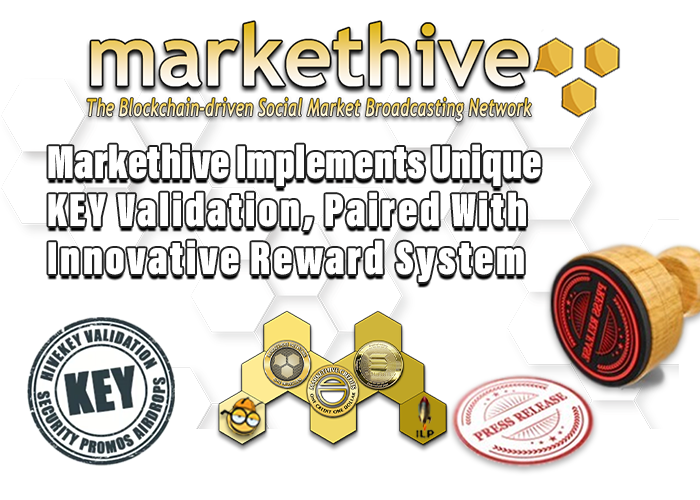
SEO Strategy In 2020 – Focus On Content and Links

Even with all of the SEO trends that have been introduced over the past 25 or so years since its inception in the last decade of the 1900s, SEO in 2020 is still all about content and links. Without amazing content, you’ll never get links, and without link building, you won’t rank on the SERPs, so quality content and links should still be the foundation of any SEO strategy.
SEO is the acronym Search Engine Optimization however more to the point it should be referred to as Web Presence Optimization, after all, we are optimizing our business and web presence, not the search engine.
Content marketing and inbound marketing are synonymous as its foundational approach is creating quality content tailored to any given audience thereby acquiring customers, building trust, and loyalty. This type of marketing is not separate from SEO at all and has become an integral part of today’s SEO.
The SEO pre-2011 was a totally different mindset and the tasks were generally farmed out to search engine optimization professionals at a price. The industry became notorious for gaming search engines, particularly Google with the one-upmanship game using tactics like dark link schemes, mass forum posting, comment backlinking, and content stuffed with keywords, etc.
After one of many of Google's algorithm updates (Panda/Farmer update) in February 2011, things notably changed and Google started viewing content from a truly human perspective. Marketer’s changed the way they approached Google and no longer used the keyword density formula as stuffing keywords throughout every page was a big no-no. Marketers started focusing on content that correlated and that interested their target market.
Google continues to stay ahead of the game. Today, with their latest algorithm named BERT, which is based on user intent rather than a focus on content/page to keyword matching. It’s a user-focused optimization, using real people to evaluate websites. These Quality Raters are not SEO professionals but are trained to assess the pages according to the amount of expertise, authoritativeness, and trustworthiness of the page’s main content as well as the creator of that content.
Two Factors Determine High-Quality Content In Google
As we know Google’s algorithm changes constantly, but there are two human inputs that can affect how your content shows up in search results.
Behavioral Analysis: Google looks at user behavior factors like the dwell time and average time on page.
Quality Raters: Google hires humans who manually check their search results using quality rating guidelines.pdf
As it’s all about humans and how they consume content and their effect on search engine rankings, we need to ensure our content satisfies not only the technical but the human requirements also.
The Human Touch Required For The Pillars
Expertise, Authoritativeness, Trustworthiness, otherwise known as E-A-T are the pillars of Google’s quality rater guidelines and are only used to help Google evaluate changes, and do not directly impact rankings. The guidelines exist to help raters assess “Page Quality” and “Needs Met”, so it is simply a term Google created to teach quality raters what to look for.
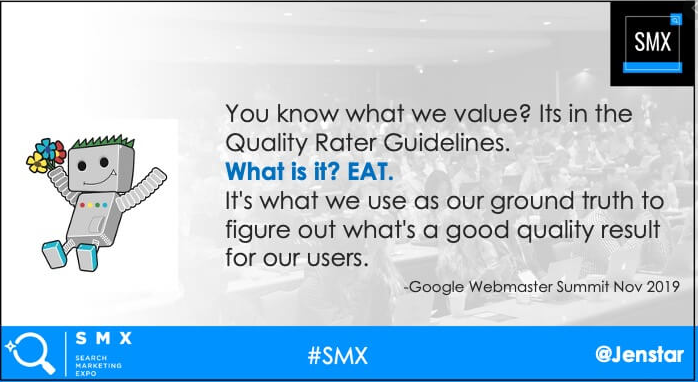
Google emphasizes Expertise, Authoritativeness, Trustworthiness – EAT to ensure trust in their search results.
Page Quality
Jennifer Slegg, the editor for the SEM Post, explains how Google assesses E-A-T,
“They said that the best-known signal is PageRank — that means links.”
Google may count links from other authoritative sites in your sector as vouching for your page.
Slegg provided as a rule of thumb,
“You want to make sure that you’re putting out content that other people will feel good about linking to. In addition to amassing backlinks, publishers can bolster their E-A-T by citing their sources, including author bios and credentials, hiring authors that are experts in their field, adding “about” info and contact details, and managing their reputation and reviews.”
Needs Met
“Needs Met” refers to how well your page satisfies the user’s query.
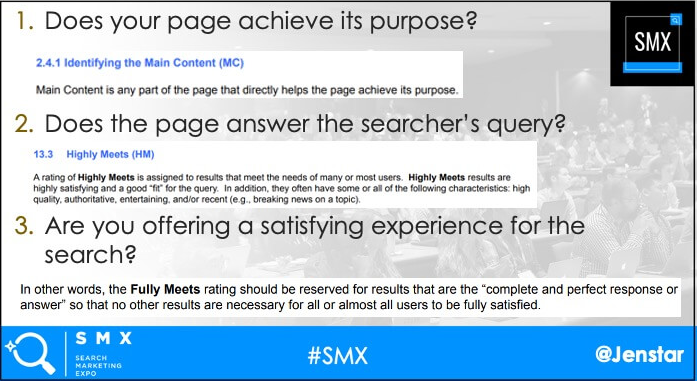
Slegg goes on to explain,
“If you want to get the ‘Fully Meets’ ranking for this, which is the highest-ranking you can possibly get, you need to ensure that your content is completely answered what searchers are looking for,”
So how can we improve our Needs Met ranking? One way is to see what keywords are getting users to your site and assessing that against your landing page. Also by having all your content on a single page rather than spread across numerous pages that would cause users to have to click on subsequent pages, may lower the likelihood of users returning to the search results only to click on your competitors’ listing.
Low-quality signals are considered to be pages that are not mobile-friendly, misleading or clickbait titles, ad-blocked content, and intrusive advertisements, so the quality raters are instructed to assign the lowest rating available.
“Google knows that sites need to have ads to support revenue,” Slegg noted, “it’s more about the types of ads.”
These pieces of content are ranked by their order of usefulness and relevance to the user performing the search.
And that means, in order for your content to have any SEO value at all, it needs to be beneficial to searchers.
How do you make sure it’s beneficial? The infographic below gives you some guidelines recommended by Google.
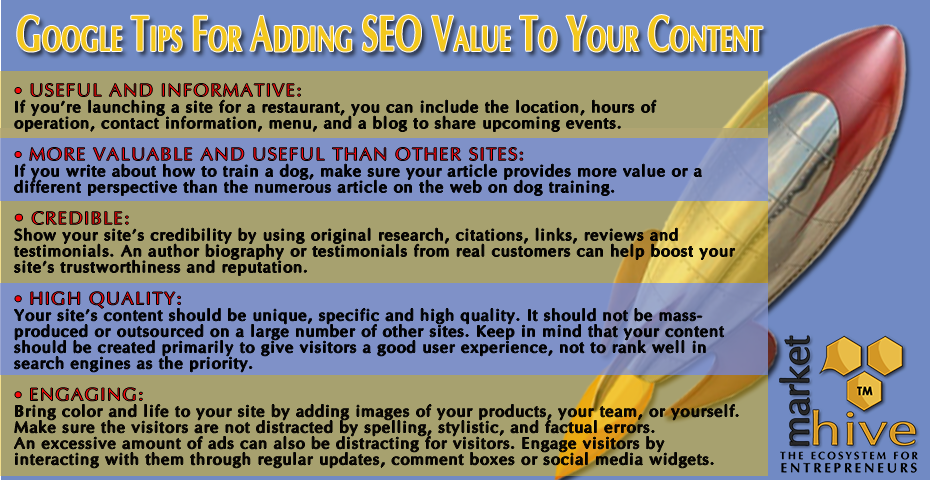
Social Media Now Considered Backlinks
Social relationships are now considered the new backlinks. In other words, you begin following people who have similar topics to yours and when you start building relationships, they will share your content from their social media turf. The more influential content-related people who share your content, the more impact it has on rankings. SEO is becoming a social butterfly that creates a network of substance and purpose.
A Community That Comments Is A Good Thing
Do blog comments help your rankings? According to Google, the answer is YES!
In fact, Google stated that the community on your site that comments on your blog or article can help “a lot” with ranking.
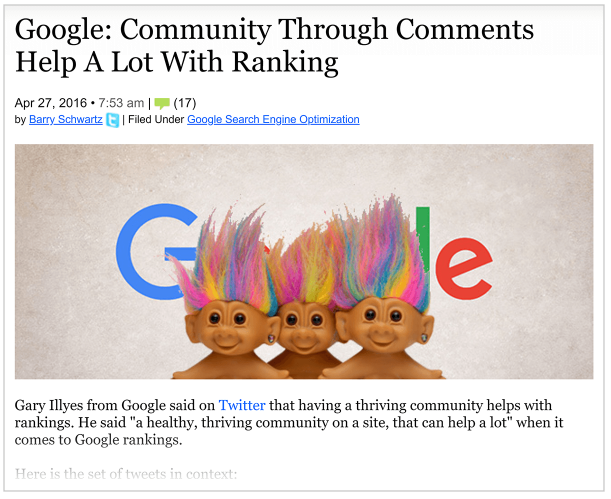
Subsequently, Gary Illyes from Google said that “Comments are better on-site for engagement signals for SEO than moving to social.”

In other words, Google now wants to see that you have an active community on your site.
It’s extremely worthwhile to share "the love" with other social media platforms in terms of creating a greater reach. This is where Markethive excels as fully explained in this article written by the CEO of Markethive, Thomas Prendergast, a master at the art of marketing.
Markethive is the ecosystem for entrepreneurs from all walks of life that not only includes a comprehensive inbound marketing suite but a social media platform where like-minded individuals network focusing on collaboration, sharing content and ideas, with the added advantage of Blockchain security and financial sovereignty.
It’s a platform that highlights the cottage industry with sovereign storefronts and oodles of content all pointing to and from the platform. It’s the perfect umbrella for any business to improve their exposure and reach.
With the classification of the next generation Market Network, Markethive has advanced exponentially in terms of traffic and Alexa Ranking. Thanks to the Markethive community with its professional approach to mastering the basic techniques of SEO, facilitating their individual businesses while engaging on the social platform, there’s little wonder that Markethive is a force and showing all the signs of dominating the Social Inbound Marketing paradigm.
Statistics updated Sept. 29, 2020
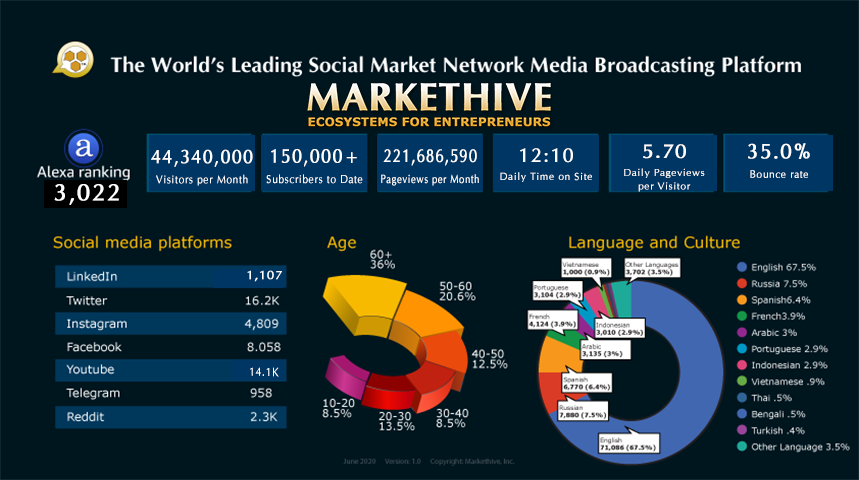
Markethive is not totally dependent on Search Engines as an individual marketer going it alone might be. It has built its own society (and continues to do so) so its traffic is contingent to the Markethive membership driving more traffic in, due to the nature of its platform, what it has to offer, the viral aspect, and the rewards system in place.
Having said that, there are simple things we can do to optimize our content with the Markethive blogging system and keep within the guidelines of what is accepted or frowned upon on major search engines.
Adding to that it’s beneficial to be aware of the continuous changes and updates our beloved Google does to its search engine.
How Can You Optimize Your Content In Markethive?
Content optimization doesn’t need to be difficult. It’s certainly one of the easier elements of SEO to understand and since Markethive is in essence an Inbound Marketing platform with content being of paramount importance it makes sense to understand how you can optimize your blogs to improve rankings.
You need to ensure you’re following a process and adhering to best-practice guidelines. However, you first need to understand why certain elements contribute toward an optimized page and also what to do to implement these into your content.
Content remains one of Google’s strongest ranking signals, but it’s important to create content with a purpose. You should never just publish blog posts or other types of content just for the sake of doing so.
Typically, you’ll be publishing content to meet one of a number of goals, including:
• To rank on the SERPs.
• To earn links.
• To educate an audience.
• To drive social engagement.
• To generate leads.
11 Elements To Optimize Your Blog
When it comes to creating the perfectly optimized page, there’s a simple checklist which you can follow:
Be Keyword Targeted
Keyword research should always be the starting point when writing. It’s important to align the content you create with your keyword research.
Although search engines have been minimizing the importance of keywords signals for a while now, they still play a role in ranking your content in the SERPs.
The focus is now more than ever on keyword phrases (long-tail phrases) and the skillful use of these phrases in a manner that is appropriate for the way search engine optimization works today.
This guide will show you the importance of understanding the authority strategy that aligns with E-A-T.
Shorter URLs Are More Search Engine Friendly
As far back as 2008, Google’s Matt Cutts said that a 3 to 5 word URL is optimal and that, with those which are longer, “Google’s algorithms typically will just weight those words less and just not give you as much credit.”
Specifically, URLs at position #1 on the first page of Google are on average 9.2 characters shorter than URLs that rank in position #10.
Short URLs may improve SEO in terms of a higher organic click-through rate (CTR) as shown in this study that short URLs have a higher CTR vs. long URLs. Also, short URLs may help Google understand what your page is all about.
So shorter URLs have a correlation with higher rankings. The average URL on Google’s first page is 66 characters long. Be sure to also include your main target keyword in the URL.
Optimize Your Title Tag
The title tag of a page is one of the most important on-page SEO elements, yet one which is so simple to get right. The best place to start when writing an optimized title tag is your target keyword.
Most title tags on Google’s first page contain keywords that are an exact or partial match of any given search, so it makes sense to describe what your page is about in your title tag.
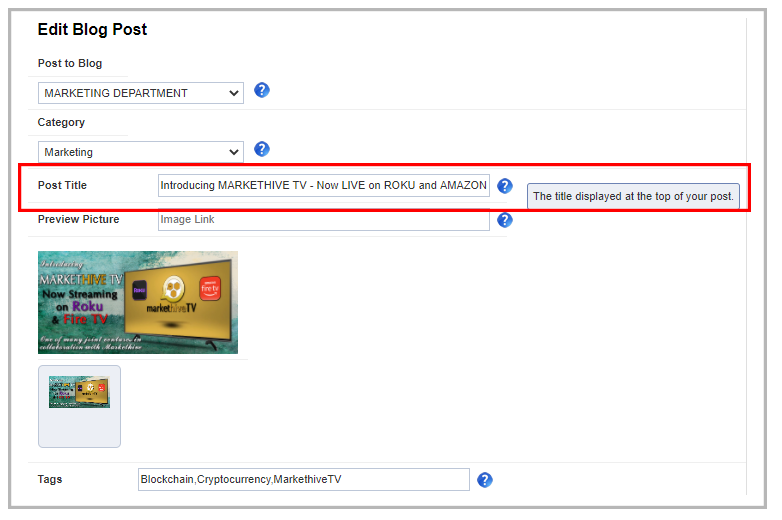
Because your title tag gives the people searching and search engines an overview of your content’s overall topic, it should presumably have a significant impact on rankings as pointed out in the Google SEO Guide.
It appears that a keyword-rich title tag may be a “ticket to entry” that can help you get to the first page. However, once you’re on the first page, using the exact keyword in your title doesn’t appear to help you climb the rankings.
That’s where other factors like backlinks, Domain Authority, and user experience signals (like bounce rate, time on site, organic click-through-rate) appear to play a large role.
Optimize Your H1 Tag
Your H1 tag is generally the same as the title or at least has the keywords pertaining to the title. When using the Markethive blogging platform this can be found in the editor at the top along with all the other formats available.
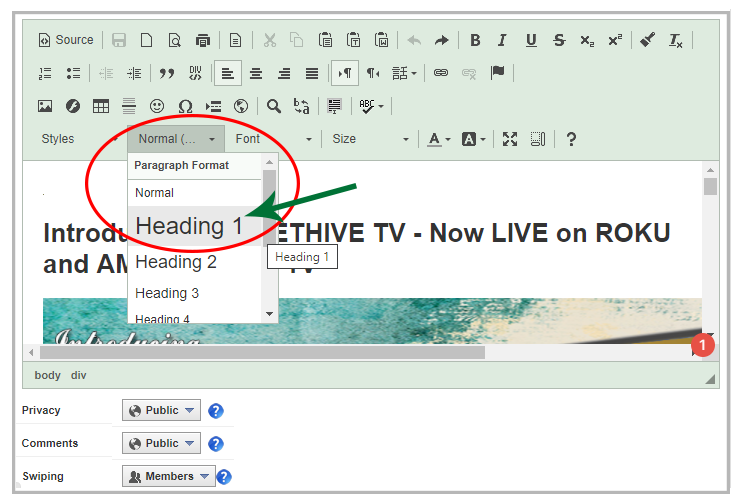
As with title tag optimization, H1s may be a “ticket to entry” factor that can help you crack Google’s first page. But keyword-rich H1s may not be strong enough of a ranking signal to help a page move up the first page results. However, optimizing every aspect of your blog without going overboard can’t hurt.
Target Keyword in the First Paragraph
There is no need to forcefully work your target keyword many times over throughout your entire content. Keyword stuffing is now considered “NOT COOL” and is frowned upon by search engines.
It is important that you do use your primary keyword within the content, however, it needs to be done so in a natural fashion. It’s recommended that you include this within the first paragraph of content on the page.
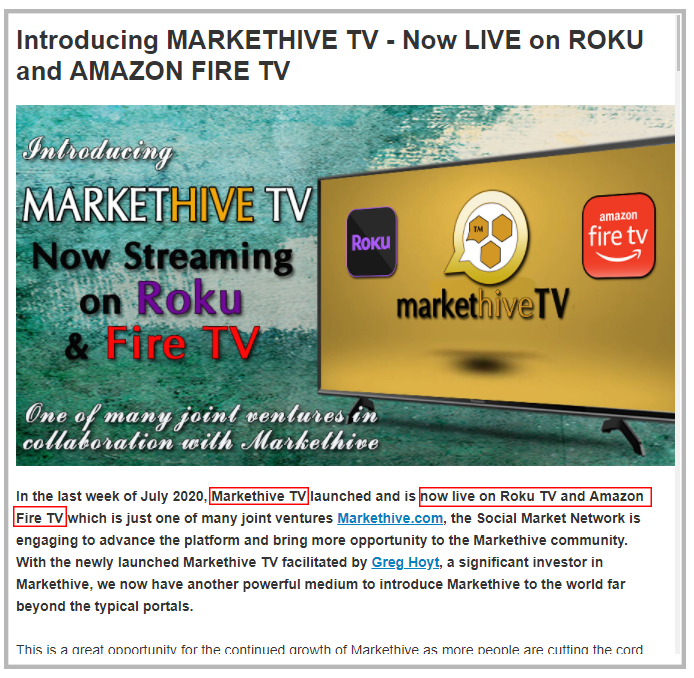
In the case of our Markethive TV article, this could be done easily by opening with something along the lines of what you see in the image above Notice how it isn’t forced but fits nicely in the opening paragraph? That’s what you need to aim for. You will also notice I have included internal links using anchor text.
Optimize Your H2 Tags
You’ve already wrapped your page heading in an H1 tag, but you need to also make sure you’re wrapping subheadings in H2 tags (or H3 – 6 if there are headings under other subheadings).
Think of H tags as a hierarchy, where you’re wrapping the most important title in an H1 and work your way down the page. If all your subheadings contextually carry the same weight, use H2 tags for these. If there are clear sections within these, use H3 and so forth in a logical order.
Don’t fall into the trap of stuffing your target keyword straight into an H2 tag but include variations that make sense to the content. In this example below, you may open the main body of content, after your H1 tag and introductory paragraph, with this variation.
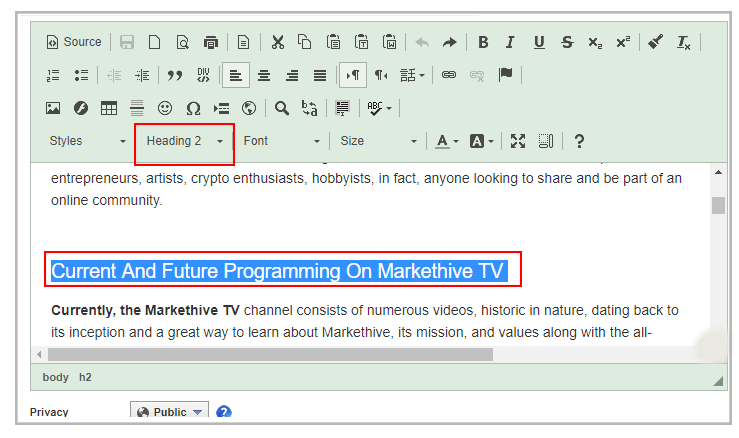
Here, it’s highlighting clearly the overall theme and keyword focus – Markethive TV – however, there is an obvious variant describing what viewers can expect at present and in the future. Keep H2 tags concise and remember you don’t need to have a keyword variant every time as long as your content flows contextually.
Use Of Images & Video
The use of images and video within content has a positive impact upon dwell time, or how long someone stays on the page. Also, using video and images, which also includes the likes of infographics and charts, makes content easier to read and consume.
It’s a well-known fact that many of us are able to absorb and understand easier when content is visualized through an infographic or listened to via video. Furthermore, it nicely breaks up the text which can be seen as overwhelming to some readers, especially when it’s a comprehensively long article.
Notably, writing comprehensive, in-depth content can help pages rank higher in Google, and according to this study when it comes to acquiring backlinks, long-form content significantly outperforms short blog posts and articles. Content longer than 3000 words gets an average of 77.2% more referring domains.
From an SEO perspective, content that engages users more will have a positive impact upon dwell time. From the perspective of search engines, it makes sense that the longer a user spends consuming content on a site, the more useful it is in comparison to one with a much lower dwell time.
Just be sure to fully optimize images and embed videos from YouTube, Vimeo, Wistia, or other video hosting and streaming platforms.
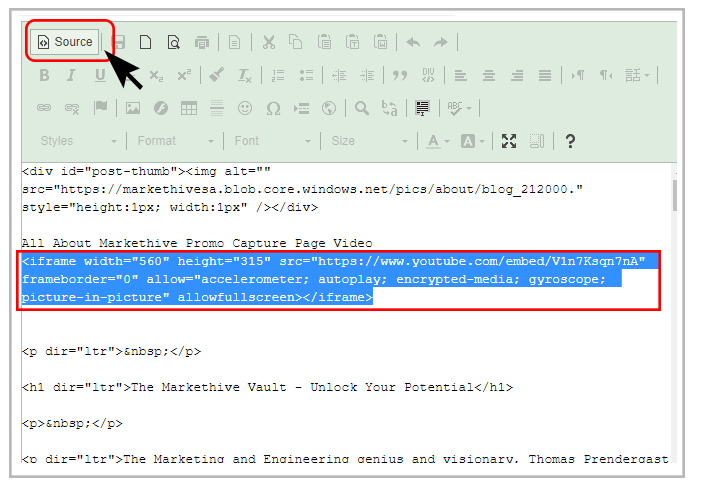
Outbound Links Do Improve SEO
Not so long ago, SEO professionals were scared to link out to external content. Why?
The worry of “leaking PageRank.”
This was based upon a tendency to maintain as much PageRank as possible internally within a website and to avoid linking out. However, from an editorial perspective, that doesn’t make sense.
Outbound links are one way that people and search engines discover useful content. They are important because they can improve organic traffic, build trust, and even facilitate relationships with other businesses.
Don’t be afraid to link out. If you’re citing a source, go ahead and link to it. It not only helps users to read further into a sub-topic but also allows search engines to better understand relevancy based upon content you’re linking to.
Derek Gleason at CXL Institute explains how outbound links in your article align with a users-first approach to content,
“If you really believe that your content marketing is there to benefit your users, I think you have to link to competitor content. They’re the other sites that are most likely to have created authoritative content on topics similar to those you cover. If you feel anxious about doing that, it’s a bit naive. Your users know that competitors exist. They’re going to find their websites one way or another. If anything, a willingness to link to others’ content may even reinforce why you’re the better resource as users know that you’ll give them full, honest answers.”
Just be mindful to link to authoritative sources. Don’t accept money from third-parties to link to their content from your own. Essentially, link to anything that adds value and makes the life of the user easier, so they don’t have to go search out resources themselves.
Balance Your Content With Internal Links
Internally linking through to other key pages on your site is a must. Internal linking is a key way to navigate both users and search engines through your content and help to spread link equity to key pages.
In the most simplistic form, if you’re mentioning a topic within your content which you have a page or post about, link to it. Don’t be afraid to link using anchor text, either. For example, if content talks about Backlinking and you have a previous relevant article that expands on your topic, by all means, link it, as I’ve done here.
How many internal links should you add to your content? There’s no hard rule. Don’t go internally linking to anything and everything (and certainly don’t be forcing keywords in just to link), but link where it makes sense, and the target page adds value.
Page Speed
Although page speed can be an important factor for the user, and always considered to have a critical impact on digital marketing, and ranking, Backlinko recently analyzed 11.8 million search results to find no correlation between page loading speed (measured by Alexa) and first page Google rankings. However, it’s always best practice to strive for faster page speeds and when it comes to content, image size is a major contributing factor, so it’s important to optimize your images.
Social Share Buttons
Social shares are becoming more of an influence when it comes to search results, and social media profiles do rank in search engines. It’s also important that readers are able to share your content.
Even if organic search is one of the reasons why you’re creating a piece of content, the end result is that you want eyeballs on it which create your reach and hopefully convert into business.
Social share buttons are located at the bottom of each of your blogs on the Markethive Blogging template which will appear as soon as you hit publish.
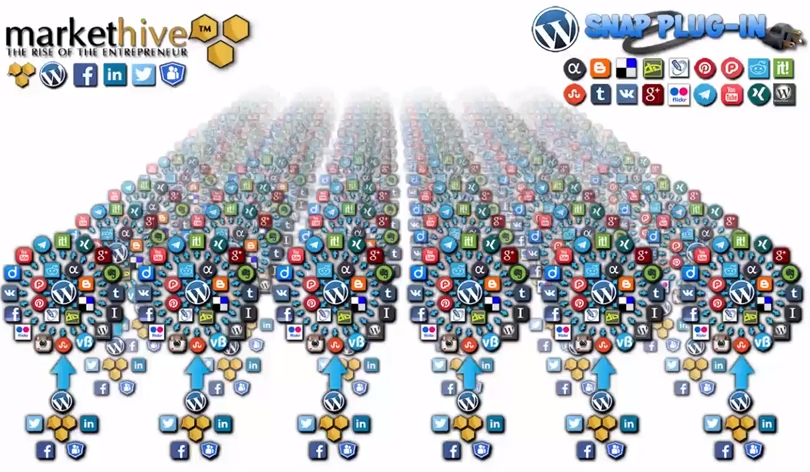
In Conclusion
In 2020, it’s time to re-evaluate the quality of content and optimizing content for users rather than search engines. The key to staying successful in search marketing 2020 has been consistent throughout, publish good authoritative content, with consistent brand messaging, in all your channels.
As the search engines adapt more to natural language understanding, the best-written content in all forms will win out.
When you create content that is highly useful, engaging, or entertaining, and be seen as reliable enough to your audience that they would willingly return again to your site, or even seek you out above others, you’ve most certainly gained authority.
Users and customers are getting smarter and they expect more when it comes to marketing. The more they trust you, the more they are willing to share your content (links), talk about you (value), and buy your products (revenue).”
Markethive has built a system on the Blockchain to empower the Entrepreneur, offering privacy, freedom of speech, and importantly, autonomy. Markethive with its numerous plugins, different domains, layouts, content, etc, all feeding from Markethive but feeding into them.
We could literally have hundreds of thousands of websites all interconnected inside through the Blockchain from the outside having no possible connection, each one producing its own unique content. Some can be ranking really high, others not so much, but all feeding back into Markethive.
As Google evolves into a more humanistic search engine along with its updates, could and has resulted in a disruption of other sites’ and their standing in SEO. This will not affect Markethive, in fact, you could say it’s like trying to kill the Hydra.
Markethive, the company, is focused on providing a Universal type of income for aspiring entrepreneurs. We believe in sharing our resources with you as you build your business and seek to reach your goals.
There is so much involved in the world of SEO, it can be very intimidating, however, Markethive has got you covered and committing to learn and carrying out the basics outlined here can lead to a fruitful association within the entrepreneurial ecosystem.
Sources:
https://searchengineland.com/
https://www.searchenginejournal.com/
https://backlinko.com/

Deb Williams
A Crypto/Blockchain enthusiast and a strong advocate for technology, progress, and freedom of speech. I embrace "change" with a passion and my purpose in life is to help people understand, accept, and move forward with enthusiasm to achieve their goals.
TP


